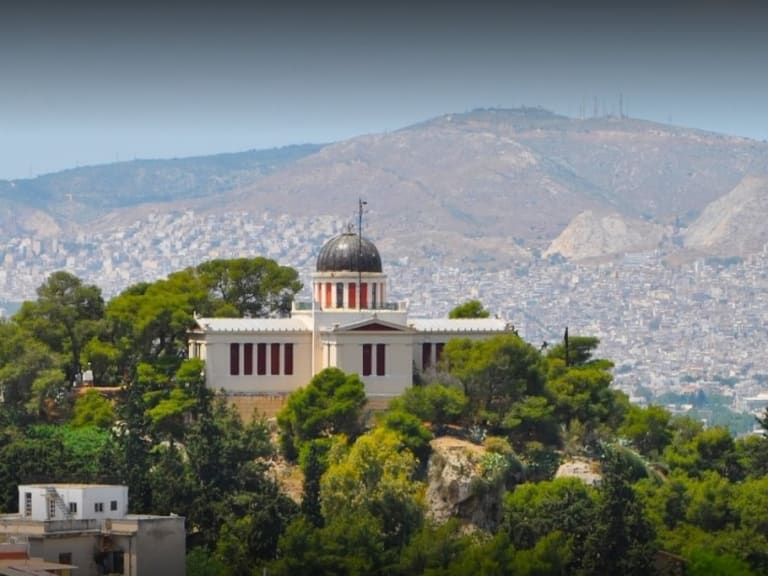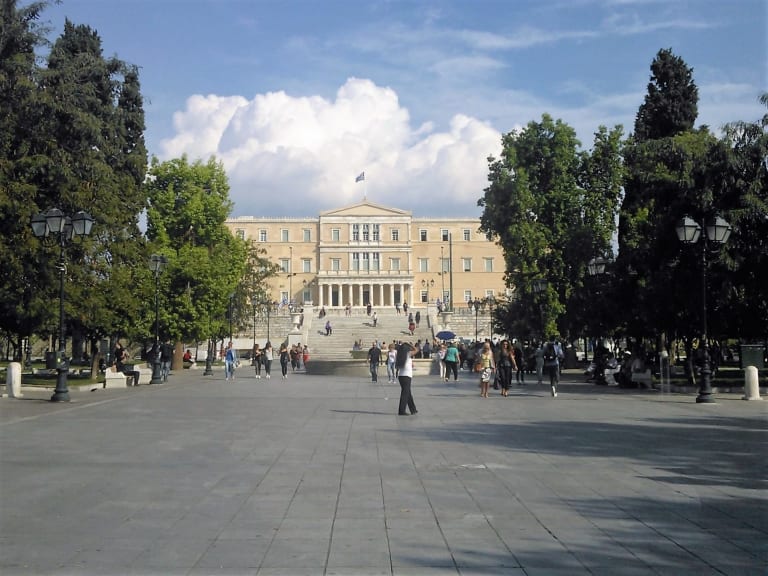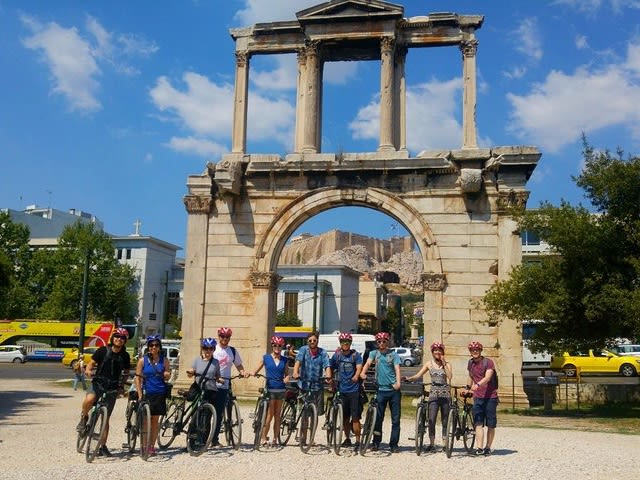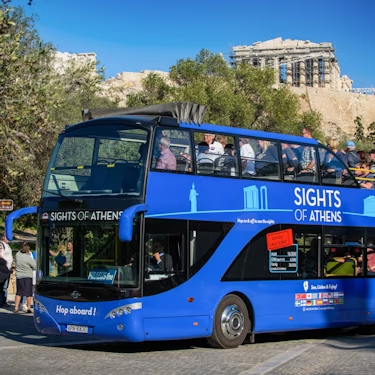More about: 10 Things to Do in Athens in Summer
Many of the best things to see and do in Athens happen during the summer. Which is logical, as this is the peak season for international tourism and Greece specifically is a leading tourist destination within the European Union.
I've found activities that can keep you entertained right in the city centre as well as the best summer plans just outside the city centre. Read on through this informative compilation and I guarantee you'll have a better idea of what to see and do when you land in the capital of the cradle of Western civilisation.
1. Have a cocktail on some of Athens' famous terraces

Going up to enjoy a summer evening on the terraces of the city's buildings is a very Mediterranean tradition from the Spanish coast to the southernmost tip of the Israeli shores. Clearly, this is also a very important custom in Greek culture and you can't miss this ritual on your visit to Athens in the summer for several reasons.
The first is that Athens is known for its frequent winds and this can help you cope with the high temperatures of the European summer. Especially in a region that has suffered from increasingly extreme summers in recent years.
The second reason is that you will be offered panoramic views of the scenery of Athens illuminated by moonlight and with a direct view of the Acropolis mountain. The latter depending on the area of the city you choose.
Psyri and Gazi are two neighbourhoods with an ideal nightlife scene for you to enjoy this Greek tradition. They also combine a vibrant cultural and party scene that can transform a short evening of drinking into an evening that lasts until dawn the next day.
Depending on the establishment you choose , I advise you to book in advance on the website or on the venue's social networks. Many of them have such a revolutionary or modern approach to Greek gastronomy in Athens and Mediterranean cocktails that they fill up with tourists every single day of the summer.
2. Take in a screening at one of the many open-air cinemas in the city

Another evening and summer activity that defines the experience of living and visiting Athens at this time of year is the open-air cinemas. Throughout the city there are some 40 cinemas with these structural features and perhaps the most famous of them all is the Thisio Cinema. It offers a direct view of the illuminated acropolis that stands out from behind the projection screen.
These cinemas are characterised by offering alcoholic beverages that also accompany the available shows as a simultaneous entertainment. In addition, you should know that almost all of these establishments run a line-up of films that are either subtitled in English or are in English and have Greek subtitles.
Clearly, this is one of the best things to do in Athens at night not only because of the excellent entertainment it offers but also because of the savings associated with this activity. Most of these shows have a minimum fee of less than 5 euros per ticket or are completely free of charge.
This is due to the fact that every summer there is an Athens Open Air Film Festival which usually runs from mid-June to the end of August. If the film belongs to this film circuit, it is very likely to be an auteur film with an excellent quality and a very European style.
3. Enjoy a visit to the National Observatory of Athens

Spending the summer in the Mediterranean is an extremely enjoyable experience until you have to start looking for alternative plans that go beyond beach activities. That is, to escape the oppressive heat that can occur during the days of this time of year. Fortunately, the Greek capital is a vibrant and diverse city with venues such as the National Observatory of Greece. It offers a cool and safe space to escape the high temperatures, while experiencing a visit to a place of significant historical importance to the entire Western world.
You can enjoy guided tours in Greek and English, as you tour a building created in 1842 that sits on the Nymphs' Hill of Mount Philoponus, right in the historical and touristic heart of the city. Inside you will find various items of importance such as the telescope that was used to create the first detailed map of the lunar surface or those used today to observe celestial spectacles.
Keep in mind that this is one of the first planetariums in the western hemisphere and is also the first scientific research institution in Greece after its independence from the 500-year occupation by the Ottomans. In addition, the clarity of the summer skies makes a visit to this planetarium even more recommended during these months of the year. Going beyond the environmental comfort it offers to visitors escaping the Greek heat.
You have to keep in mind that this observatory is very close to the tourist epicentres of the city such as the Acropolis or the neighbourhoods of Monastiraki and Plaka. For this reason, you could use the best tourist buses in Athens to get around the area if you are also interested in enjoying a tourist audio guide of the areas you pass through in this section of the city.
Interesting details
- Prices: Admission is free, but guided tours usually cost 5 euros per person.
- Duration: It is open until around 11pm on most summer days and depending on your interests it can take 2 or even 3 hours to explore the interior.
4. Tour the Athens Riviera

For many years it seemed unthinkable that the coastline around the Greek capital would become a tourist destination worthy of being visited and enjoyed by locals and foreigners alike during the summer season. However, many of the beaches that are a little further away from the cruise ports in Athens make the Riviera of Attica Region as interesting as Mykonos or Santorini.
In fact, the sea swimming spots near the Greek capital have been approved for excellent water quality by the European Environmental Agency. This is a distinction that is not offered to just any area on the continent and is definitely not assigned to many tourist regions that receive bathers all summer long anyway.
Specifically the southern suburbs of the city are an ideal place for such beach visits within the mainland section of Attica. Glyfada stands out among other alternatives for its proximity to the centre of Athens, for the wide commercial and cultural variety it handles and for being accessible by train on the red line from the urban epicentre of Athens.
Asteras Beach is one of the best known, while Paralia Kavouri is one of the local secrets that, despite being further away, is often preferred by Athenians.
5. Don't hesitate to organise a picnic in the hills of Athens

Summer in Athens is full of traditions and picnics on one of the city's many hills is one of those secrets that are not shared with the hordes of tourists. However, they are within the reach of those who do a good amount of research for their trip, like you right now.
Specifically, there are 4 hills that should catch your attention for this activity and these are the Hill of the Nymphs, the Mount of the Muses, the Areopagus or Mount Lycabettus. All of them are easily accessible from the neighbourhoods that surround them in the urban bases of the city. Moreover, on a good afternoon you will enjoy a view of the horizon that will allow you to see as far as the sea on the shores of the port of Piraeus and other coastal communities of the Athens Metropolitan Area.
In the case of Mount Lycabettus there is a cable car that takes you to the top in less than 10 minutes and the Areopagus is notable for its proximity to the Acropolis of Athens. This makes it very convenient to book some of the Acropolis tours or excursions on the same day as your picnic.
I recommend that you go shopping in the streets closest to these respective hills of the city. This is so you can enjoy Greek summer delicacies such as salads of olives, tomatoes and feta cheese fresh from an authentic Athenian kitchen. Don't forget to bring a blanket to cover the ground so you have somewhere to sit and enjoy the beautiful sunset.
6. Visit the National Archaeological Museum

This is the largest museum in all of Greece and covers an area of about 8,000 square metres, housing some 11,000 historical items. Most of these are from the period when Ancient Greece was the most important empire in all of Western culture and laid the foundations of what our modern societies are today.
It has been open to the public since 1889 and will remain open throughout the summer season. This time of year is a favourable time to visit because many tourists will want to tour its facilities, but most of them will be focused on other types of entertainment. Just like the Greek islands or the mainland coasts of the country.
That means it will be an iconic part of the city that really will be available to be toured in comfort. That's while offering you a break from the tourist-filled streets and hustle and bustle that characterises the tourist epicentres of Athens at this time of year.
As you will already be in the area, you can take the opportunity to walk the streets of Exharcheia, the neighbourhood where this museum is located. It is characterised by its modernity and at the same time by its anarchic identity, which has always had a significant influence on the cultural and political life of Athens.
Details of interest
- Prices: there are days that are constantly changing for free access for tourists, but in general the entrance fee is 5 to 6 euros for people over 18 years old. Guided tours are available for 50 euros for groups of up to 5 people.
- Duration: You can spend 4 or even 5 hours touring it if you pay close attention to all the exhibits.
7. Visit the islands closest to the city

Clearly, Greece is internationally known for the significant number of islands it has in its national territory. There are approximately 6,000 of them and you will probably want to visit some of them even if your focus of interest when visiting this beautiful corner of the Mediterranean is its capital, Athens.
The city has several ports from which excursions to the Greek islands depart from Athens. Salamina, Aegina and Kea are some of the most important, with the clearest waters and the closest proximity to the city.
The first of these is notable for its geographic size and its significant proximity to the Greek mainland. So if you decide to visit, you will probably need more than 48 hours to get to know all the coasts that offer very different beach environments. At least if you compare the northern coasts with the southern coasts of Salamina.
Details of interest
- Prices: The best way to get to these islands is by excursions, which usually combine several islands in a single itinerary on a single date. Firstly to save time and secondly to save money. Fares are almost always around 130-140 euros per person with up to three destinations on the same itinerary.
8. Take a swim in Vouliagmeni Lake

This lake is known as a healing space within the Athenian Riviera and is actually a very curious geographical corner. It is a kind of marine spring that receives its brackish water through an underwater cave.
It is one of the best kept secrets of those who really investigate entertainment options for short day trips from Athens. This small brackish water lake is located a short 25 kilometres south of the city centre of the Greek capital.
Its temperature is quite favourable and the water for some unknown reason is full of minerals. But the real attraction of the place is the beauty of the landscape that characterises its surroundings. In fact, it has been a natural monument for a couple of years.
It has cafeterias, changing rooms and even a restaurant. In fact, many people living in the Vouliagmeni area go there without the need to be interested in bathing in this beautiful lake.
Details of interest
- Prices: Access to the lake has varying rates depending on the day of the week of the visit and the age of the person. On average you can expect entrance fees of around 15 euros per adult and around 6 euros for children between 12 and 6 years of age. Children under the age of 6 are free.
- How to get there: You can get there by driving a private car for about half an hour, although there are bus routes that will take you to Vouliagmeni and that means you will have to pay a taxi fare to the entrance of the lake.
9. Experience a concert at the Odeon of Herodes Atticus

The Odeon of Herodes Atticus is an amphitheatre dating from 161 AD. It suffered serious damage in 267, the result of an invasion of the city. By 1954, however, it had been restored and by 1957 it was functioning for the same purpose as it does today. That is, to host live entertainment ranging from theatre, dance, concerts, operas and televised shows.
Nowadays it is one of the most important points for the activities of the Athens Festival. It consists of a host of cultural events that run from May to September in the city's theatres, cinemas and concert halls thanks to the financial support of the Athens City Council.
If by the time of your summer visit to the Greek capital you happen to coincide with a show of your interest taking place at the Odeon of Herodes Atticus, then it is imperative that you buy tickets for it. You would be attending one of the oldest and most important amphitheatres in the history of mankind.
I advise you not to forget a blanket or a cushion to sit on, as these are completely rigid marble seats that can become a bit uncomfortable after being on them for 1 hour in the same position.
10. Visit Syntagmatos Square and watch the changing of the Greek Guard

Syntagmatos Square, known as Syntagma in English, is located in the geographical centre of Athens, in the area near the Plaka neighbourhood, right next to the National Garden of Athens. The area surrounding the square is also home to the Hotel Grande Bretagne, a hotel that has been in operation since 1874 and is a favourite haunt of the city's most famous visitors.
Ermou Street is one of the most commercial areas of the city and is also on the edge of this important square which is known as Constitution Square. This is because of its connection with the revolutionary movement that led to the drafting of this national document in 1843.
As the Hellenic Parliament is also located in this square you have the opportunity to witness one of the most curious and entertaining traditions of the city. This is the changing of the guard of the army that guards a monument dedicated to the Greek soldiers who have died in battles for their country.
This small replacement takes place every hour from 10 am until sunset. Now, summer is an ideal time to visit this square because of the fact that there will be a very significant entertainment offer around this very important point of the city. And it is actually a transit area between many of the sites you will visit in this part of the city.
To escape the heat I suggest you take part in one of the Athens bike tours that will surely have a stop at this square and will also take you to other important monuments in the area.
Temperatures in Athens in summer

Estimates always indicate that the maximum temperatures in Athens in the summer months can be as high as 33 degrees Celsius. However, the truth is that they can go up to 40 or 43 degrees Celsius because this has already happened. As for minimum temperatures, you can expect 21 to 22 degrees Celsius for the nights of the summer months.
Athens Summer Tourist Attractions in Athens

Athens is full of tourists during the summer and this is something you should bear in mind when planning your trip. Bear in mind that this is not unsustainable tourism either, as it is not a city that is known for getting uncomfortably crowded at the main attractions.
Prices in Athens in Summer

Summer is the most expensive time of the year to visit Athens because demand is high and supply is clearly limited. My recommendation is to buy or book as much as possible in advance, as this will ensure more favourable prices than having to pay for services on the spot.
What to pack to visit Athens in summer?

Wear comfortable, breathable clothing, as you'll be doing a lot of walking every day of your visit and conditions will remain dry and hot throughout your trip. Footwear is another important factor, as it needs to be comfortable but also suitable for all kinds of activities.
Don't forget sunscreen if you have to use one with a specific dermatological formula, as it will be a hassle to search all the pharmacies in town for it.




